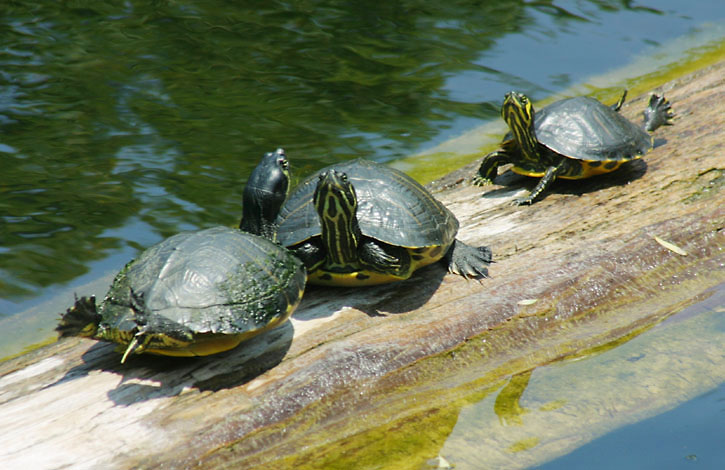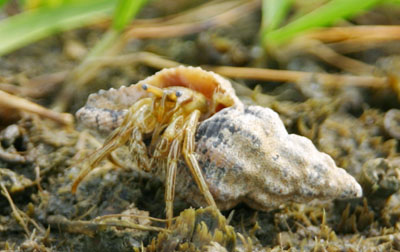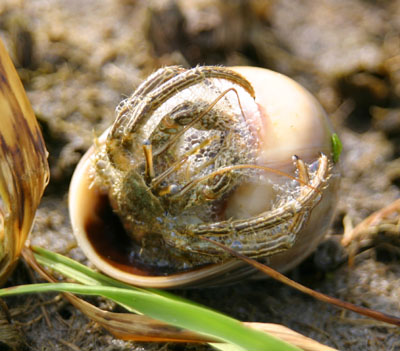
Lest you get the impression that all I could get photos of during our recent trip were captive animals, I feel obligated to show off the beasts captured au naturel – which actually means “naked” I think, which also applies, but isn’t exactly what I meant. Anyway…
The NC Aquarium at Fort Fisher features an outdoor area of gardens, bogs and ponds, wherein resided the Yellow-bellied Sliders (Chrysemys scripta scripta) seen at top. Like every aquatic turtle I’ve seen, these spent a lot of their time basking on logs and rocks in the water, warming up and drying out some of the weeds and algae that grow on their shells, but always alert for danger. They’re kind of like the timid base-stickers during Tag games when I was a kid, never venturing far from a safe haven they could run back to at the first sign of being caught. Spoilsports. Two of these display a behavior I haven’t yet found explained (not that I’ve tried very hard,) holding their rear legs high and wide while basking. It makes it appear like two reckless sledding turtles are about to crash into the poor guy in the middle…
 Plants, unless they’re very exotic-looking, don’t really hold my interest, but I’ll examine them carefully to find the insects that they host. Parsley plants in the garden were getting ravaged by Black Swallowtail caterpillars (Papilio polyxenes asterias), who seem to favor that plant above all others. They’re very brilliant in color, getting brighter as they get larger, and will make their chrysalises right on the plants they consumed if the time is right.
Plants, unless they’re very exotic-looking, don’t really hold my interest, but I’ll examine them carefully to find the insects that they host. Parsley plants in the garden were getting ravaged by Black Swallowtail caterpillars (Papilio polyxenes asterias), who seem to favor that plant above all others. They’re very brilliant in color, getting brighter as they get larger, and will make their chrysalises right on the plants they consumed if the time is right.
[Photographer’s note: As I type this late at night, I’m hearing thunder in the distance, and considering taking the equipment out to a likely spot to photograph lightning. After having left Florida, I’m in withdrawal from decent lightning opportunities – we have few electrical storms and even fewer good viewing locations here in NC. But the weather radar shows sporadic storm cover, difficult to plot a course to intercept the front, so I guess I’m staying put.]
The following day, after an abortive attempt to find a place to snorkel (I’ve about given up on this in NC,) we checked out River Road Park on the Cape Fear River, a place mostly distinguished by a small boat launch and fishing pier. I did a few scenic shots, just about the only ones on the trip, on the quiet river and bordering marshland. I also spent some time chasing pics of the Fiddler Crabs that ruled the area, but these are all on film, medium-format no less, so I won’t have these back for a while (especially since I’m waiting to finish off two more rolls before shipping them for processing.) The crabs were so numerous that the ground appeared to be alive at times as they scampered for cover, and it only took a brief wait, remaining motionless, to let them venture back out again. This was worth the wait, because they were displaying that morning, waving the larger of their two pincers (claws) in the air hypnotically. To the best of my knowledge, this both intimidates other male crabs and shows off for females, serving the same purpose as saggy pants among human males… okay, maybe not. But I witnessed one curious bit of behavior while there: one crab, lacking the large claw distinctive of the species, nevertheless actually chased another crab of similar size back down into its burrow rather aggressively. I guess it’s true when they say it’s not about size, but what you do with it.
 The last day of our trip, we elected to take the ferry over to Southport, and while waiting we wandered around the public access area just beyond the ferry port. We’d been there the day before and chased a few obligatory pics of wading birds near the boat launch, but this time we went to the northwest side of the point onto a small beach area. Here, still early in the morning, the Thin-stripe Hermit Crabs (Clibanarius vittatus) were foraging at the edges of the peat where it gave way to sand. I think a lot of people miss this, because the crabs will retract into their protective borrowed shells as danger approaches, and the motionless shells in the beach grasses don’t attract attention. Again, a little patience pays off, and soon enough they’ll emerge slowly from the shell and return to foraging. Typically when they retract the shell opening is facing the ground, but I cheated a bit by rocking the shells backwards a half-turn, to get sequence photos of their emergence.
The last day of our trip, we elected to take the ferry over to Southport, and while waiting we wandered around the public access area just beyond the ferry port. We’d been there the day before and chased a few obligatory pics of wading birds near the boat launch, but this time we went to the northwest side of the point onto a small beach area. Here, still early in the morning, the Thin-stripe Hermit Crabs (Clibanarius vittatus) were foraging at the edges of the peat where it gave way to sand. I think a lot of people miss this, because the crabs will retract into their protective borrowed shells as danger approaches, and the motionless shells in the beach grasses don’t attract attention. Again, a little patience pays off, and soon enough they’ll emerge slowly from the shell and return to foraging. Typically when they retract the shell opening is facing the ground, but I cheated a bit by rocking the shells backwards a half-turn, to get sequence photos of their emergence.
 The one shown here had produced a nice little cluster of bubbles that filled the shell opening, which might have worked against it. Many species of crabs do this for a number of reasons, and I suspect this one was either keeping its gills moist, or performing an aggressive display. What it meant was that, as it slowly peeked back out to see if the coast was clear (Ha! Take that, Dave Barry!) it had to get its eyes past the froth.
The one shown here had produced a nice little cluster of bubbles that filled the shell opening, which might have worked against it. Many species of crabs do this for a number of reasons, and I suspect this one was either keeping its gills moist, or performing an aggressive display. What it meant was that, as it slowly peeked back out to see if the coast was clear (Ha! Take that, Dave Barry!) it had to get its eyes past the froth.
The tails, or at least the rearmost part of the body, in many crustacean species serves some interesting purposes. In shrimp, crayfish, and lobsters, it’s a heavily-muscled escape mechanism, remaining stretched out relatively straight until danger looms – this is often determined by something contacting their long antennae. The tail then snaps closed against the belly, propelling the crustacean backwards at an impressive speed, taking it out of danger in an eyeblink. Hermit crabs also have long tails that usually remain hidden deep within the shells. Not only can they maneuver the shell around with it, but when threatened they do much the same thing that their cousins do, only in this case it pulls them back inside the safety of the shell in a fraction of a second. The ones I found here could all retract almost to the point of invisibility within the shell, unlike many of the land hermits you can occasionally purchase at pet stores and cheesy beach souvenir shops. I suspect this is because their smaller pincers provide less protection, as well as there being more dexterous predators in the waters here, but right now that’s only speculation.
It was a fun trip, but right now The Girlfriend and I are a little soured on the Wilmington area, because it’s become too urbanized and crowded – I never think much of beach areas where scenic shots are hard to find (and I don’t find beachfront highrises scenic.) The Outer Banks area is likely to be our next coastal destination later on this summer, though memories of the fantastic meal we had at Hieronymus Seafood restaurant might draw us back down from time to time ;-)




















































